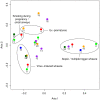A disease model for wheezing disorders in preschool children based on clinicians' perceptions
- PMID: 20046874
- PMCID: PMC2795203
- DOI: 10.1371/journal.pone.0008533
A disease model for wheezing disorders in preschool children based on clinicians' perceptions
Abstract
Background: Wheezing disorders in childhood vary widely in clinical presentation and disease course. During the last years, several ways to classify wheezing children into different disease phenotypes have been proposed and are increasingly used for clinical guidance, but validation of these hypothetical entities is difficult.
Methodology/principal findings: The aim of this study was to develop a testable disease model which reflects the full spectrum of wheezing illness in preschool children. We performed a qualitative study among a panel of 7 experienced clinicians from 4 European countries working in primary, secondary and tertiary paediatric care. In a series of questionnaire surveys and structured discussions, we found a general consensus that preschool wheezing disorders consist of several phenotypes, with a great heterogeneity of specific disease concepts between clinicians. Initially, 24 disease entities were described among the 7 physicians. In structured discussions, these could be narrowed down to three entities which were linked to proposed mechanisms: a) allergic wheeze, b) non-allergic wheeze due to structural airway narrowing and c) non-allergic wheeze due to increased immune response to viral infections. This disease model will serve to create an artificial dataset that allows the validation of data-driven multidimensional methods, such as cluster analysis, which have been proposed for identification of wheezing phenotypes in children.
Conclusions/significance: While there appears to be wide agreement among clinicians that wheezing disorders consist of several diseases, there is less agreement regarding their number and nature. A great diversity of disease concepts exist but a unified phenotype classification reflecting underlying disease mechanisms is lacking. We propose a disease model which may help guide future research so that proposed mechanisms are measured at the right time and their role in disease heterogeneity can be studied.
Conflict of interest statement
Figures

Similar articles
-
[Standard technical specifications for methacholine chloride (Methacholine) bronchial challenge test (2023)].Zhonghua Jie He He Hu Xi Za Zhi. 2024 Feb 12;47(2):101-119. doi: 10.3760/cma.j.cn112147-20231019-00247. Zhonghua Jie He He Hu Xi Za Zhi. 2024. PMID: 38309959 Chinese.
-
Epidemiology of asthma and recurrent wheeze in childhood.Clin Rev Allergy Immunol. 2002 Feb;22(1):33-44. doi: 10.1007/s12016-002-0004-z. Clin Rev Allergy Immunol. 2002. PMID: 11803801 Review.
-
A new model of wheezing severity in young children using the validated ISAAC wheezing module: A latent variable approach with validation in independent cohorts.PLoS One. 2018 Apr 17;13(4):e0194739. doi: 10.1371/journal.pone.0194739. eCollection 2018. PLoS One. 2018. PMID: 29664908 Free PMC article.
-
Recurrent Severe Preschool Wheeze: From Prespecified Diagnostic Labels to Underlying Endotypes.Am J Respir Crit Care Med. 2021 Sep 1;204(5):523-535. doi: 10.1164/rccm.202009-3696OC. Am J Respir Crit Care Med. 2021. PMID: 33961755 Free PMC article.
-
Wheezing in preschool children.Early Hum Dev. 2013 Oct;89 Suppl 3:S13-7. doi: 10.1016/j.earlhumdev.2013.07.017. Epub 2013 Aug 31. Early Hum Dev. 2013. PMID: 24001476 Free PMC article. Review.
Cited by
-
Diagnosis of allergy and asthma in childhood.Curr Allergy Asthma Rep. 2011 Feb;11(1):71-7. doi: 10.1007/s11882-010-0156-5. Curr Allergy Asthma Rep. 2011. PMID: 21052877 Free PMC article. Review.
-
Asthma trajectories in early childhood: identifying modifiable factors.PLoS One. 2014 Nov 7;9(11):e111922. doi: 10.1371/journal.pone.0111922. eCollection 2014. PLoS One. 2014. PMID: 25379671 Free PMC article.
-
Childhood asthma: diagnosis and treatment.Scientifica (Cairo). 2012;2012:674204. doi: 10.6064/2012/674204. Epub 2012 Dec 13. Scientifica (Cairo). 2012. PMID: 24278725 Free PMC article. Review.
References
-
- Silverman M, Grigg J, Mc Kean M. Virus-induced wheeze in young children - A separate disease? In: Johnston S, Papadopoulos N , editors. Respiratory infections in allergy and asthma. New York: Marcel Dekker; 2002. pp. 427–471.
-
- Brand PL, Baraldi E, Bisgaard H, Boner AL, Castro-Rodriguez JA, et al. Definition, assessment and treatment of wheezing disorders in preschool children: an evidence-based approach. Eur Respir J. 2008;32:1096–1110. - PubMed
-
- Kuehni CE, Davis A, Brooke AM, Silverman M. Are all wheezing disorders in very young (preschool) children increasing in prevalence? Lancet. 2001;357:1821–1825. - PubMed
-
- Martinez FD, Wright AL, Taussig LM, Holberg CJ, Halonen M, et al. Asthma and wheezing in the first six years of life. N Engl J Med. 1995;332:133–138. - PubMed

